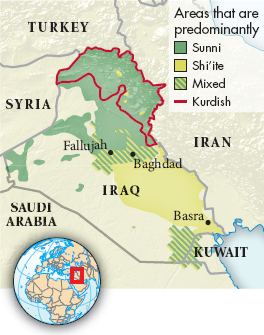Turmoil in the Muslim World
Residents of North America and Europe expressed surprise and shock at the vehemence of the September 11 and other terrorist attacks, but radical Islamist hostility toward the West had a long history. Radical political Islam, a mixture of traditional religious beliefs and innovative social and political reform ideas, was at first a reaction against the foreign control and secularization represented by the mandate system established in the Middle East after World War I (see "The Peace Settlement in the Middle East" in Chapter 25). Groups like the Muslim Brotherhood, founded in Egypt in 1928, called for national liberation from European control and a return to shari’a law (based on Muslim legal codes), and demanded land reform, extensive social welfare programs, and economic independence. By the 1960s, the Muslim Brotherhood had established chapters across the Middle East and North Africa, and a variety of other groups and leaders advocated similar ideas about the need for Islamic revival and national autonomy. The broad spectrum of Islamist ideas is difficult to summarize, but adherents tended to fall into two main groups: a moderate or centrist group that worked peacefully to reform society within existing institutions, and a much smaller, more militant radical minority willing to use violence to achieve its goals.
Decolonization and the Cold War sharpened anti-
U.S. policies in the Middle East at times produced “blowback,” or unforeseen and unintended consequences. For example, the mujahideen, the Muslim guerrilla fighters in Afghanistan who successfully fought off the Soviet army there from 1979 to 1989 (see "From Détente Back to Cold War" in Chapter 28), were the recipients of substantial amounts of U.S. military aid and arms. Many of the mujahideen would go on to support the Taliban, a militant Islamist faction that came to rule Afghanistan in 1996. The Taliban established a strict Islamist state and provided a safe haven for the Saudi-
As a result of these policies, the United States, along with western Europe, became the main target for Islamist militants. During the 1990s, bin Laden and al-
The Bush administration hoped that the invasions of Afghanistan and Iraq would end the terrorist attacks and bring peace and democracy to the Middle East, but both instead increased turmoil there. The military campaign in Afghanistan quickly achieved one of its goals, bringing down the Taliban, and the United States installed a friendly government. But U.S. troops failed to find bin Laden or disable al-
With heavy fighting still under way in Afghanistan in late 2001, the Bush administration turned its attention to Saddam Hussein’s Iraq, arguing that it was necessary to expand the war on terror to other hostile regimes in the Middle East. U.S. leaders effectively played on American fears of renewed terrorism and charged that Saddam Hussein was developing weapons of mass destruction. Many Americans shared the widespread doubts held by Europeans about the legality — and wisdom — of an American attack on Iraq, especially after UN inspectors found no weapons of mass destruction in the country. Though the UN failed to approve an invasion, in March 2003, the United States and Britain, with token support from a handful of other European states, invaded Iraq.

The U.S.-led invasion quickly overwhelmed the Iraqi army. Saddam’s dictatorship collapsed in April, but America’s subsequent efforts to establish a stable pro-
In early 2011, an unexpected chain of events that came to be called the Arab Spring further destabilized the Middle East and North Africa. In a provincial town in Tunisia, a poor fruit vendor set himself on fire to protest official harassment. His death unleashed a series of spontaneous mass protests that forced Tunisia’s authoritarian president to flee the country. Massive popular demonstrations in Egypt followed and forced the resignation of President Hosni Mubarak. An armed uprising in Libya, supported by NATO air strikes, brought down the dictatorial government of Muammar Gaddafi that October.
The demonstrations that opened the Arab Spring were not organized by radical Islamists but rather by young activists who sought greater political and social liberties from West-